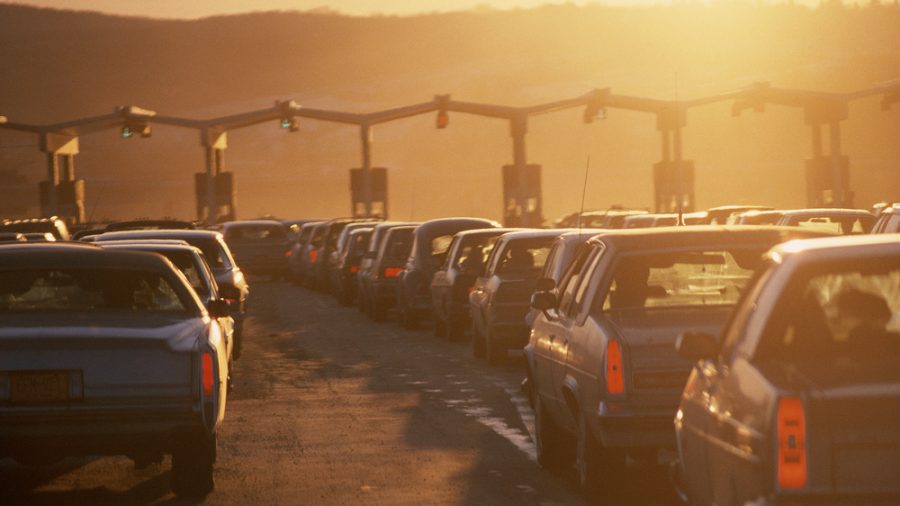No other kind of transport yet matches the private car for convenience. This is the main reason why the congestion problem won’t go away. We can manage the problem but, to reduce or get rid of it entirely seems impossible. Experts suggest it’s time for a congestion charge. But is there a more creative way to limit congestion?
Congestion problem is getting worse
Infrastructure Australia’s 2019 report sees congestion growing steadily worse. By 2031, road congestion will cost the economy $39 billion and public transport crowding $837 million per year. It’s not money well spent.
Building new roads makes no difference to congestion after a while, simply because of induced demand. The new road expands ability and ease of travel, so more people take their cars. The more people drive, the faster the road becomes congested again. At the same time, tolled motorways like WestConnex don’t have dedicated bus lanes. So these roads are of little benefit to public transport.
NRMA noted that even a 5% reduction in traffic on congested roads increases traffic speeds by half. If fewer passengers use public transport during peak hours, it could help someone else squeeze onto a bus or train.
We explore some ways to combat congestion: flexible working, remoding, addressing the mid-mile, reduced parking – and the congestion charge.
Flexible working might work
Flexible working hours would allow people to travel outside peak hours and even work at home. In a Melbourne study, only 2% of participants said none of their work could be performed outside the office. More than half could do at least half their work elsewhere.
If the two thirds of participants who currently work at home 1 day a week worked 5 days a fortnight, the number of daily commuters to Melbourne would drop by a quarter from 572,000 to 440,500 a day.
One potential drawback is peak spreading. Peak spreading occurs when more people travel outside the traditional rush hour, lengthening the morning and evening peak periods, over a bigger geographical area. This would not occur if more people worked at home.
Remoding – new modes of transport
Remoding means shifting people out of the dominant mode – cars – into public transport, active transport and shared mobility. It’s not an easy thing to do if public transport and shared mobility are not up to scratch. They have to be convenient, affordable and accessible to compete with the car.
The hub-and-spoke CBD-centric model only serves people who work in the CBD. It leaves vast areas of Sydney, where people live and work, poorly connected. Transport experts suggest setting up multi-use hubs outside the CBD. These hubs would provide access to all modes of transport and address the problem of the mid- or missing mile.
Address the missing mile
How many times have you travelled by car because your ultimate destination is too far from the nearest railway station? This is the missing mile, the gap that makes it hard for people to make the whole trip by public transport. Sometimes the last trip is just too costly or inconvenient.
Access to shared vehicles can solve this problem. GoGet says 42% of corporate users have reduced or stopped driving to work because they use shared vehicles during the day, for these mid-mile trips.
- Rather than drive to work just for the later trip, a carshare vehicle near the office gets you to the offsite meeting
- A shuttle bus picks up and drops off employees from business park to train station
- On-demand shared transport combines with public transport, eg, successful Northern Beaches Keorides trial.
Share vehicles are useful depending on what they replace. Congestion problems could actually worsen if ridesharing stops public transport patronage (as in New York) and takes up busy CBD kerb space with passenger pick-ups and drop-offs.
Reduce commuter parking
The NSW government plans to spend $350 million on commuter car parking in the next 3 years. Could the land be used more productively? Having a thousand cars doing nothing for 10 hours a day is not time or money well spent.
Reducing parking for commuters provides opportunities for retail, childcare, co-working centres or electric vehicle charging stations.
Congestion charging
Congestion is like another speed limit, slowing down traffic even more. But how many drivers consider their vehicle is part of the problem? Congestion charging forces drivers to decide whether it’s worth making that trip on that road at that time.
Some argue the charge would unfairly hurt poorer people. Yet Grattan Institute found people driving to the Sydney CBD are two to three times more likely than other workers to earn six-figure salaries. People who would be affected are those who struggle financially, need to travel on charged roads frequently or lack good alternatives to those roads. (Much the same applies to Sydney’s toll roads.)
Congestion charging allows richer drivers to pay for the right to congest, just as big companies can pay to pollute. It could ultimately divide the roads into those who can pay to congest (and pay tolls) and those who can’t. It doesn’t fix the congestion problem and makes road space for others who can pay.
The last idea for combating the congestion problem is to leave Sydney and live in the regions. This might work for people already planning some kind of seachange. But it is well documented that the majority of seachangers return again.
Interestingly, we still don’t know the true cost of using a private vehicle. We still don’t pay the proper price for parking, road maintenance or, ultimately, the effect of congestion on productivity.


your opinion matters: